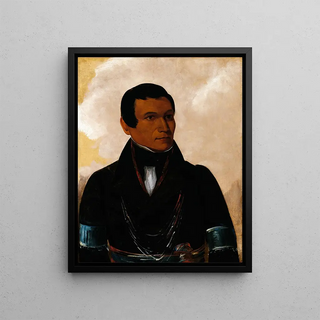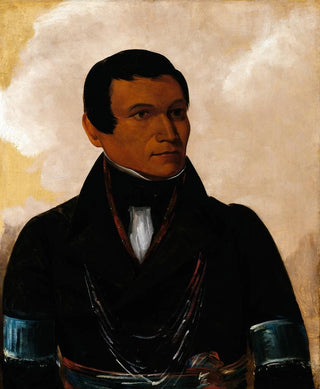Art print Fils malade du chef - George Catlin | Art print


View from behind

Frame (optional)
George Catlin's "Sick Son of the Chief" is an open window into a bygone world, an immersion into the fascinating universe of North American indigenous peoples. Through this canvas, the artist manages to capture not only the physical appearance of a young boy but also the very essence of his cultural identity. Catlin, a true pioneer of ethnographic art, offers us a poignant representation that evokes both the beauty and vulnerability of his subject. This work, marked by a deep respect for the traditions and beliefs of the peoples he encountered, invites us to reflect on the richness of their heritage and the challenges they faced.
Style and uniqueness of the work
Catlin's style is distinguished by its ability to combine realism and expressionism. In "Sick Son of the Chief," vibrant colors and meticulous details transcend mere representation to touch on emotion. The artist uses a palette of warm hues that evoke the life and culture of Native Americans, while highlighting the fragility of the young protagonist. The carefully rendered facial features reveal a psychological depth that goes far beyond physical appearance. Catlin does not simply paint a portrait; he tells a story, that of a child afflicted by illness, but also that of a people in danger of extinction. This piece is a moving testament to human resilience in the face of adversity, a quality that the artist manages to convey with rare intensity.
The artist and his influence
George Catlin, born in 1796, is often considered one of the first artists to document Native American cultures through his art. His passion for these peoples led him to travel across the United States, where he created numerous portraits and scenes of daily life. Catlin was able to capture not only the appearance of his subjects but also their spirit, culture, and traditions. His work has had a lasting influence on American art and paved the way for a better understanding of indigenous peoples. By presenting Native Americans in a human and complex light, he contributed to changing perceptions of his time.

Matte finish

View from behind

Frame (optional)
George Catlin's "Sick Son of the Chief" is an open window into a bygone world, an immersion into the fascinating universe of North American indigenous peoples. Through this canvas, the artist manages to capture not only the physical appearance of a young boy but also the very essence of his cultural identity. Catlin, a true pioneer of ethnographic art, offers us a poignant representation that evokes both the beauty and vulnerability of his subject. This work, marked by a deep respect for the traditions and beliefs of the peoples he encountered, invites us to reflect on the richness of their heritage and the challenges they faced.
Style and uniqueness of the work
Catlin's style is distinguished by its ability to combine realism and expressionism. In "Sick Son of the Chief," vibrant colors and meticulous details transcend mere representation to touch on emotion. The artist uses a palette of warm hues that evoke the life and culture of Native Americans, while highlighting the fragility of the young protagonist. The carefully rendered facial features reveal a psychological depth that goes far beyond physical appearance. Catlin does not simply paint a portrait; he tells a story, that of a child afflicted by illness, but also that of a people in danger of extinction. This piece is a moving testament to human resilience in the face of adversity, a quality that the artist manages to convey with rare intensity.
The artist and his influence
George Catlin, born in 1796, is often considered one of the first artists to document Native American cultures through his art. His passion for these peoples led him to travel across the United States, where he created numerous portraits and scenes of daily life. Catlin was able to capture not only the appearance of his subjects but also their spirit, culture, and traditions. His work has had a lasting influence on American art and paved the way for a better understanding of indigenous peoples. By presenting Native Americans in a human and complex light, he contributed to changing perceptions of his time.
12,34 €






